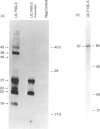Abstract
Two monoclonal antibodies (mAb), UC F6G-3 and UC F13C-5, were characterized as being specific for the apparent equine homologues of CD3 and CD5, respectively. Both antibodies exhibited characteristics of pan-T-lymphocyte markers based upon immunohistology and two-colour flow cytometry. UC F6G-3 precipitated a complex of proteins (up to seven) with molecular weights ranging from 18,000 to 42,000, similar to the human and murine CD3 complex. Upon further dissociation of the precipitated complex, two proteins were identified with molecular weights of 22,000 and 27,000. Immobilized UC F6G-3 was effective at inducing interleukin-2 receptor (IL-2R) expression on T lymphocytes, a feature consistent with antibodies specific for the epsilon chain of human and murine CD3. Three populations of cells in the thymus were distinguishable by UC F6G-3 target antigen density, suggesting increasing stages of T-cell maturation. UC F13C-5 precipitated a 67,000 MW protein, consistent with reported values for CD5 in multiple species. While this antibody exhibited characteristics of a pan-T-cell marker, low numbers of B lymphocytes also expressed the target antigen. Phorbol esters induced variable increases in target antigen density on B lymphocytes. These two antibodies, taken together with the few equine CD markers currently available, represent a substantial resource for further defining the equine immune system in health and disease.
Full text
PDF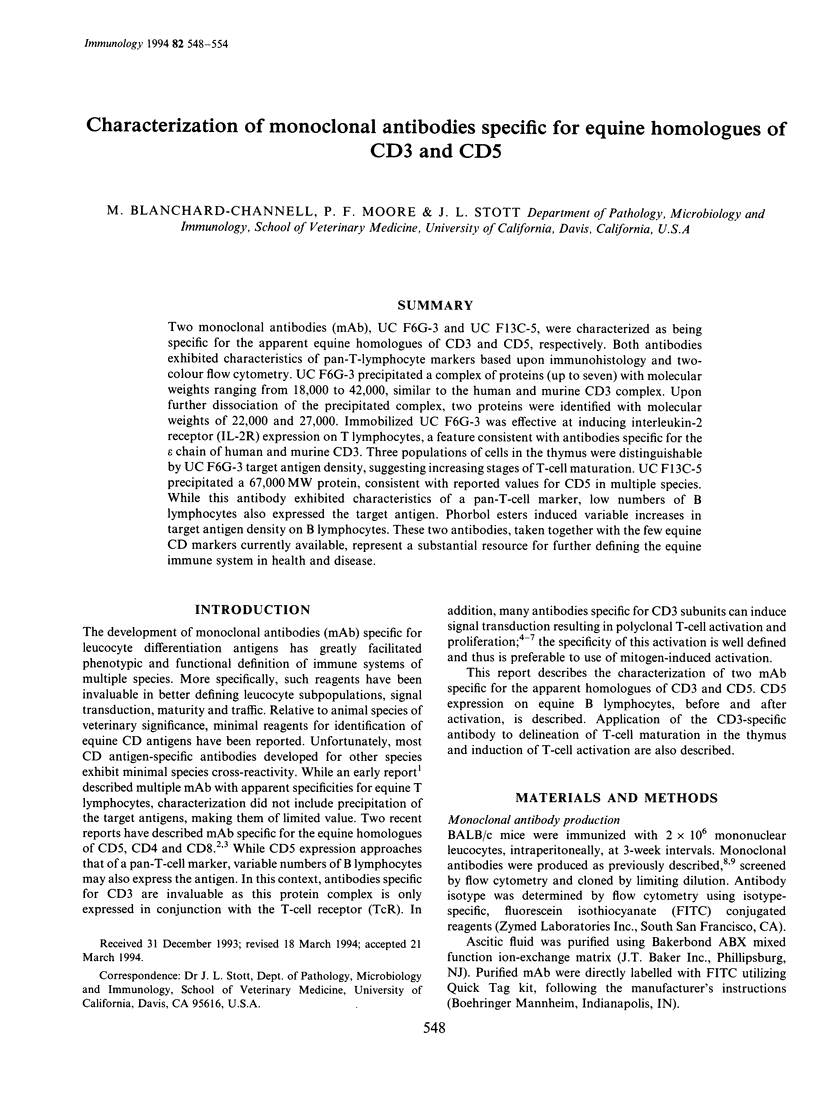
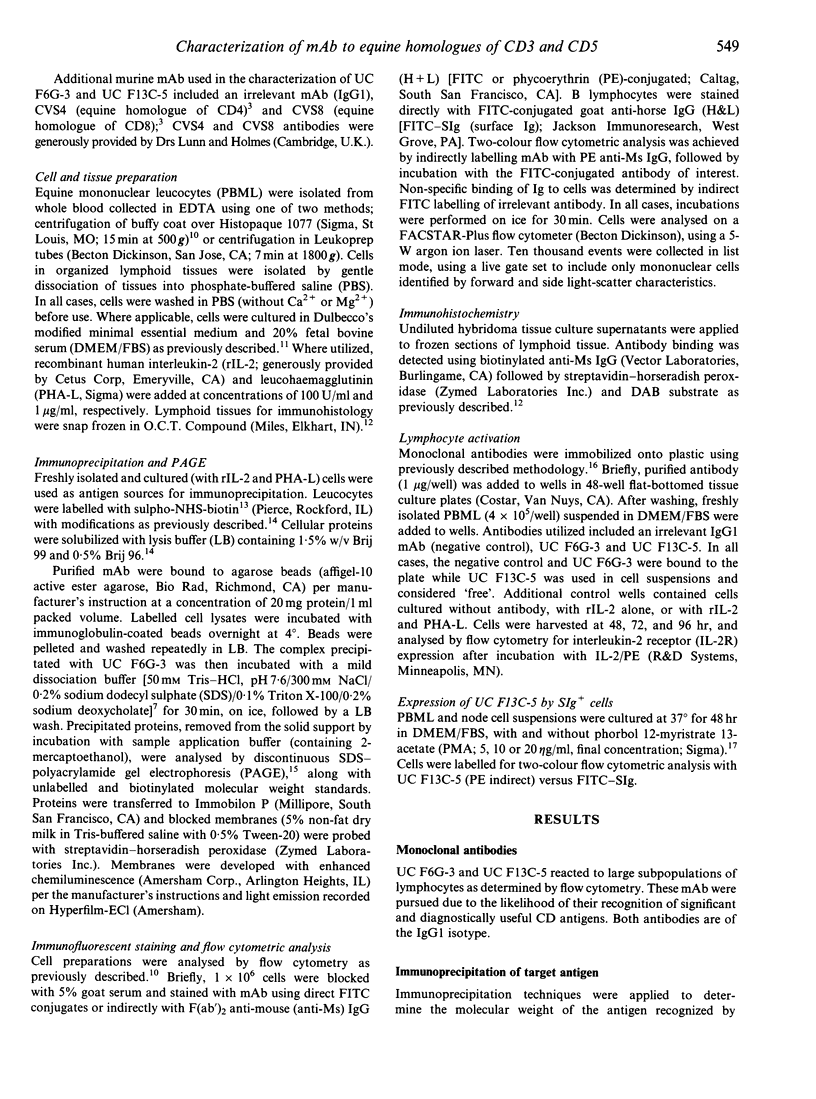
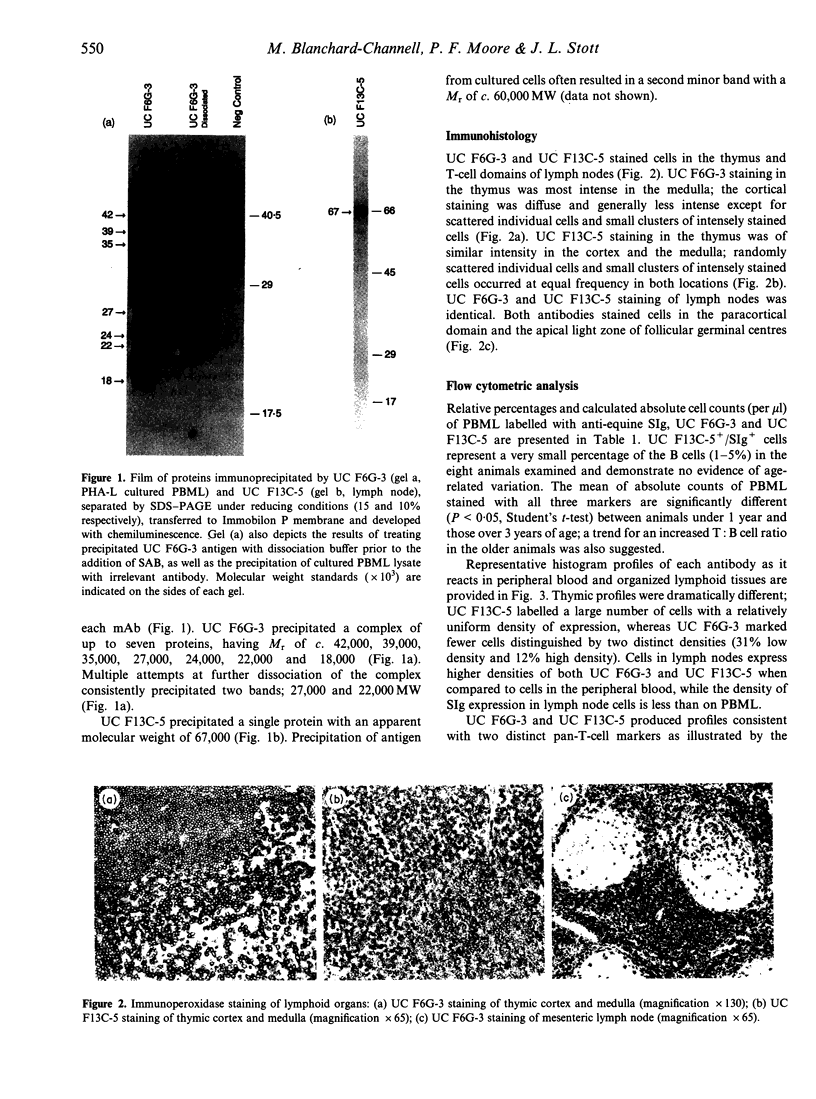
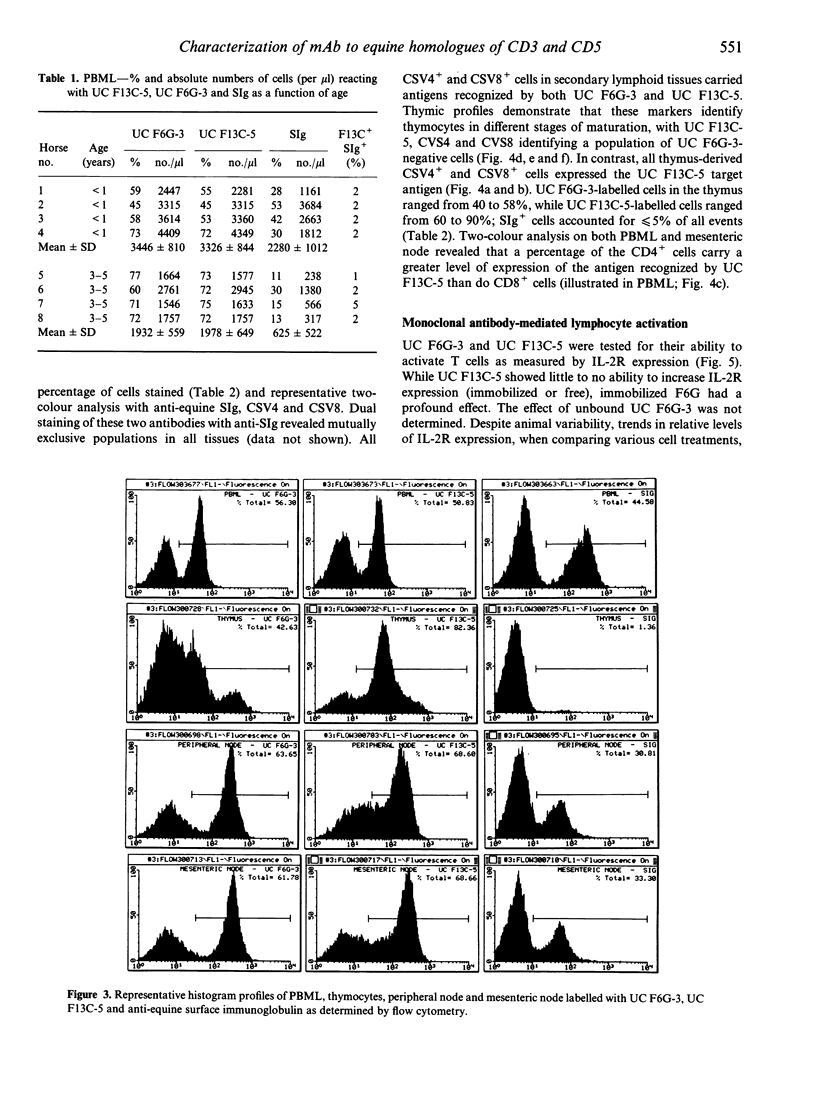
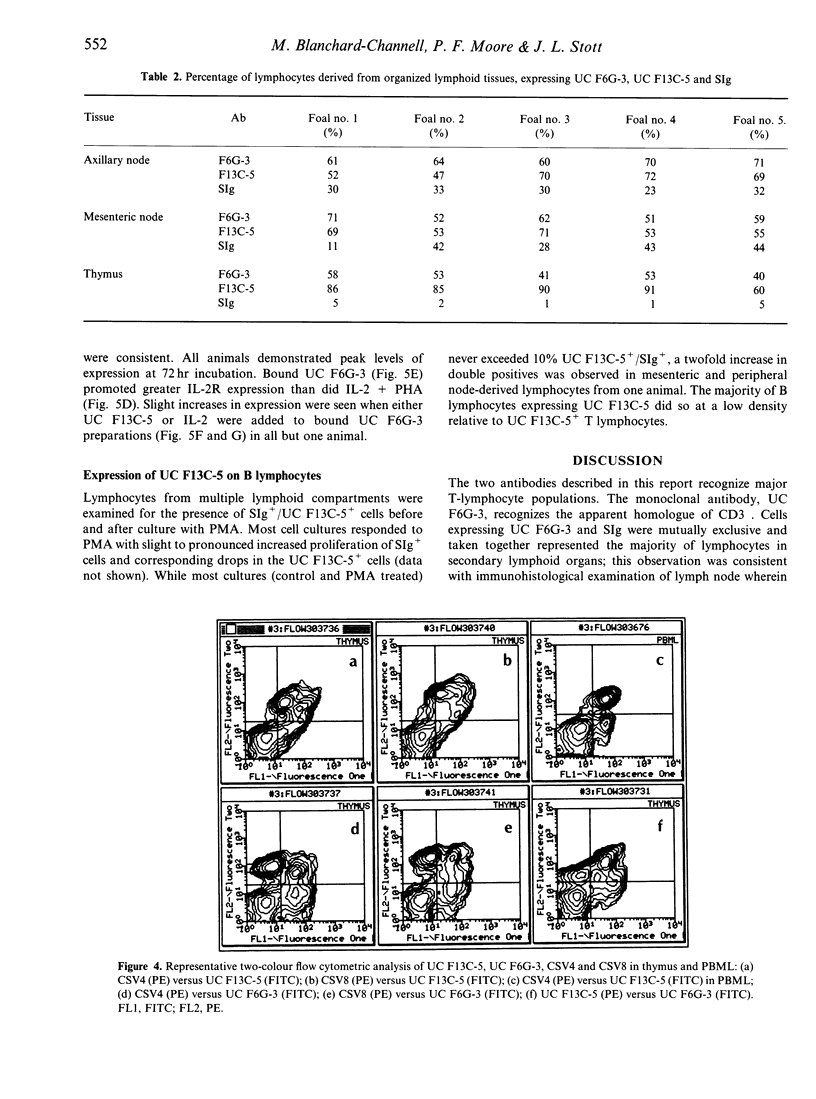
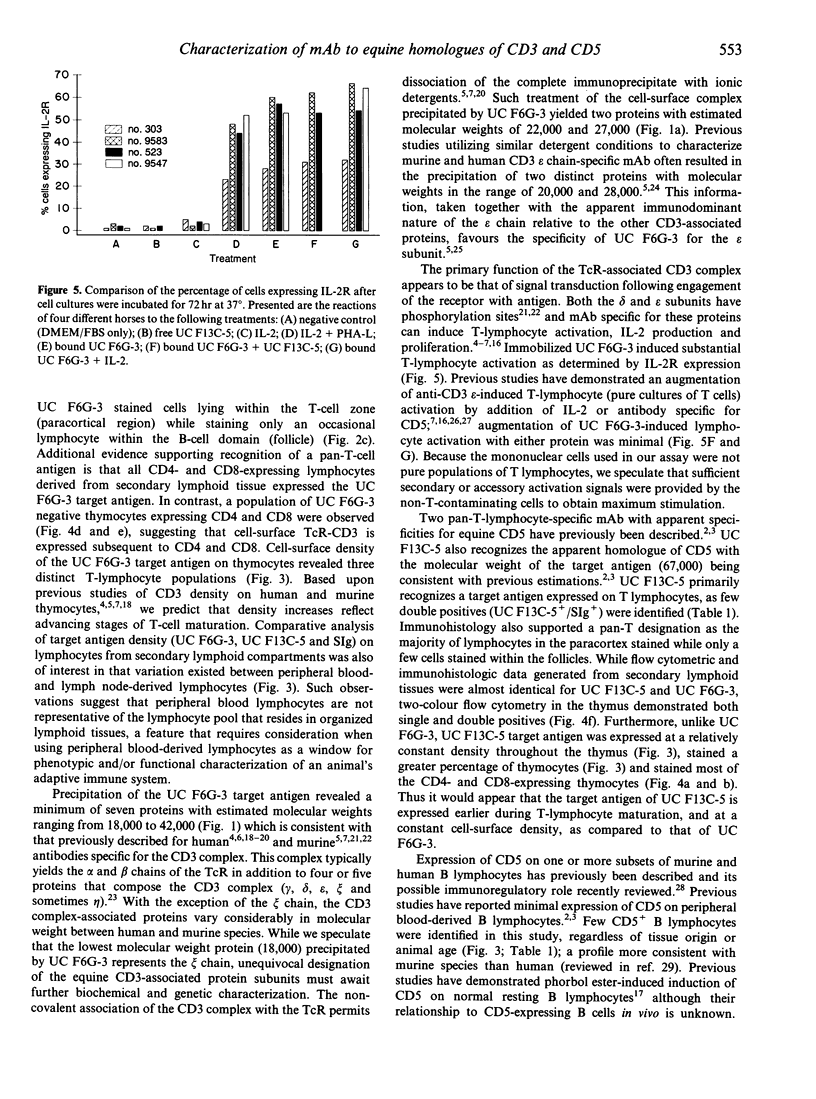
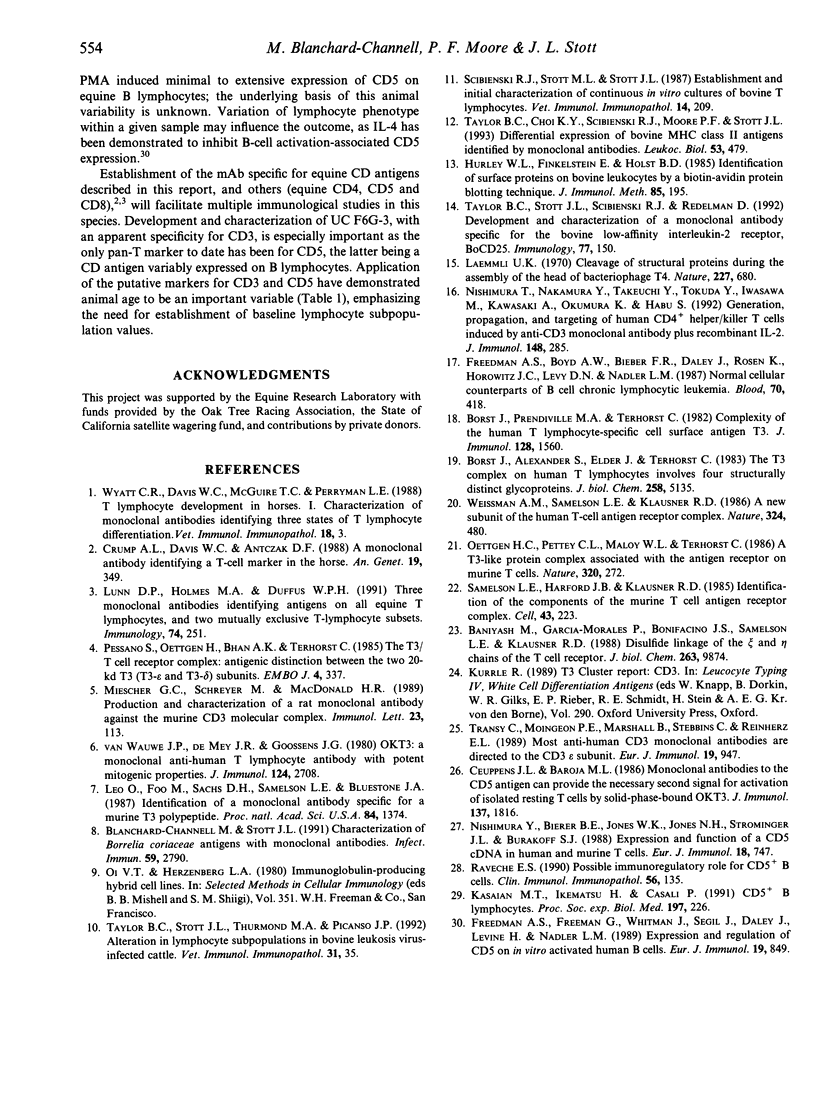
Images in this article
Selected References
These references are in PubMed. This may not be the complete list of references from this article.
- Baniyash M., Garcia-Morales P., Bonifacino J. S., Samelson L. E., Klausner R. D. Disulfide linkage of the zeta and eta chains of the T cell receptor. Possible identification of two structural classes of receptors. J Biol Chem. 1988 Jul 15;263(20):9874–9878. [PubMed] [Google Scholar]
- Blanchard-Channell M., Stott J. L. Characterization of Borrelia coriaceae antigens with monoclonal antibodies. Infect Immun. 1991 Aug;59(8):2790–2798. doi: 10.1128/iai.59.8.2790-2798.1991. [DOI] [PMC free article] [PubMed] [Google Scholar]
- Borst J., Alexander S., Elder J., Terhorst C. The T3 complex on human T lymphocytes involves four structurally distinct glycoproteins. J Biol Chem. 1983 Apr 25;258(8):5135–5141. [PubMed] [Google Scholar]
- Borst J., Prendiville M. A., Terhorst C. Complexity of the human T lymphocyte-specific cell surface antigen T3. J Immunol. 1982 Apr;128(4):1560–1565. [PubMed] [Google Scholar]
- Ceuppens J. L., Baroja M. L. Monoclonal antibodies to the CD5 antigen can provide the necessary second signal for activation of isolated resting T cells by solid-phase-bound OKT3. J Immunol. 1986 Sep 15;137(6):1816–1821. [PubMed] [Google Scholar]
- Crump A. L., Davis W., Antczak D. F. A monoclonal antibody identifying a T-cell marker in the horse. Anim Genet. 1988;19(4):349–357. doi: 10.1111/j.1365-2052.1988.tb00826.x. [DOI] [PubMed] [Google Scholar]
- Freedman A. S., Boyd A. W., Bieber F. R., Daley J., Rosen K., Horowitz J. C., Levy D. N., Nadler L. M. Normal cellular counterparts of B cell chronic lymphocytic leukemia. Blood. 1987 Aug;70(2):418–427. [PubMed] [Google Scholar]
- Freedman A. S., Freeman G., Whitman J., Segil J., Daley J., Levine H., Nadler L. M. Expression and regulation of CD5 on in vitro activated human B cells. Eur J Immunol. 1989 May;19(5):849–855. doi: 10.1002/eji.1830190511. [DOI] [PubMed] [Google Scholar]
- Hurley W. L., Finkelstein E., Holst B. D. Identification of surface proteins on bovine leukocytes by a biotin-avidin protein blotting technique. J Immunol Methods. 1985 Dec 17;85(1):195–202. doi: 10.1016/0022-1759(85)90287-x. [DOI] [PubMed] [Google Scholar]
- Kasaian M. T., Ikematsu H., Casali P. CD5+ B lymphocytes. Proc Soc Exp Biol Med. 1991 Jul;197(3):226–241. doi: 10.3181/00379727-197-43250. [DOI] [PubMed] [Google Scholar]
- Laemmli U. K. Cleavage of structural proteins during the assembly of the head of bacteriophage T4. Nature. 1970 Aug 15;227(5259):680–685. doi: 10.1038/227680a0. [DOI] [PubMed] [Google Scholar]
- Leo O., Foo M., Sachs D. H., Samelson L. E., Bluestone J. A. Identification of a monoclonal antibody specific for a murine T3 polypeptide. Proc Natl Acad Sci U S A. 1987 Mar;84(5):1374–1378. doi: 10.1073/pnas.84.5.1374. [DOI] [PMC free article] [PubMed] [Google Scholar]
- Lunn D. P., Holmes M. A., Duffus W. P. Three monoclonal antibodies identifying antigens on all equine T lymphocytes, and two mutually exclusive T-lymphocyte subsets. Immunology. 1991 Oct;74(2):251–257. [PMC free article] [PubMed] [Google Scholar]
- Miescher G. C., Schreyer M., MacDonald H. R. Production and characterization of a rat monoclonal antibody against the murine CD3 molecular complex. Immunol Lett. 1989 Dec;23(2):113–118. doi: 10.1016/0165-2478(89)90122-3. [DOI] [PubMed] [Google Scholar]
- Nishimura T., Nakamura Y., Takeuchi Y., Tokuda Y., Iwasawa M., Kawasaki A., Okumura K., Habu S. Generation propagation, and targeting of human CD4+ helper/killer T cells induced by anti-CD3 monoclonal antibody plus recombinant IL-2. An efficient strategy for adoptive tumor immunotherapy. J Immunol. 1992 Jan 1;148(1):285–291. [PubMed] [Google Scholar]
- Nishimura Y., Bierer B. E., Jones W. K., Jones N. H., Strominger J. L., Burakoff S. J. Expression and function of a CD5 cDNA in human and murine T cells. Eur J Immunol. 1988 May;18(5):747–753. doi: 10.1002/eji.1830180514. [DOI] [PubMed] [Google Scholar]
- Oettgen H. C., Pettey C. L., Maloy W. L., Terhorst C. A T3-like protein complex associated with the antigen receptor on murine T cells. Nature. 1986 Mar 20;320(6059):272–275. doi: 10.1038/320272a0. [DOI] [PubMed] [Google Scholar]
- Pessano S., Oettgen H., Bhan A. K., Terhorst C. The T3/T cell receptor complex: antigenic distinction between the two 20-kd T3 (T3-delta and T3-epsilon) subunits. EMBO J. 1985 Feb;4(2):337–344. doi: 10.1002/j.1460-2075.1985.tb03634.x. [DOI] [PMC free article] [PubMed] [Google Scholar]
- Raveche E. S. Possible immunoregulatory role for CD5 + B cells. Clin Immunol Immunopathol. 1990 Aug;56(2):135–150. doi: 10.1016/0090-1229(90)90136-e. [DOI] [PubMed] [Google Scholar]
- Samelson L. E., Harford J. B., Klausner R. D. Identification of the components of the murine T cell antigen receptor complex. Cell. 1985 Nov;43(1):223–231. doi: 10.1016/0092-8674(85)90027-3. [DOI] [PubMed] [Google Scholar]
- Scibienski R. J., Stott M. L., Stott J. L. Establishment and initial characterization of continuous in vitro cultures of bovine T lymphocytes. Vet Immunol Immunopathol. 1987 Mar;14(3):209–222. doi: 10.1016/0165-2427(87)90090-0. [DOI] [PubMed] [Google Scholar]
- Taylor B. C., Choi K. Y., Scibienski R. J., Moore P. F., Stott J. L. Differential expression of bovine MHC class II antigens identified by monoclonal antibodies. J Leukoc Biol. 1993 May;53(5):479–489. doi: 10.1002/jlb.53.5.479. [DOI] [PubMed] [Google Scholar]
- Taylor B. C., Stott J. L., Scibienski R. J., Redelman D. Development and characterization of a monoclonal antibody specific for the bovine low-affinity interleukin-2 receptor, BoCD25. Immunology. 1992 Sep;77(1):150–154. [PMC free article] [PubMed] [Google Scholar]
- Taylor B. C., Stott J. L., Thurmond M. A., Picanso J. P. Alteration in lymphocyte subpopulations in bovine leukosis virus-infected cattle. Vet Immunol Immunopathol. 1992 Feb 15;31(1-2):35–47. doi: 10.1016/0165-2427(92)90085-5. [DOI] [PubMed] [Google Scholar]
- Transy C., Moingeon P. E., Marshall B., Stebbins C., Reinherz E. L. Most anti-human CD3 monoclonal antibodies are directed to the CD3 epsilon subunit. Eur J Immunol. 1989 May;19(5):947–950. doi: 10.1002/eji.1830190525. [DOI] [PubMed] [Google Scholar]
- Van Wauwe J. P., De Mey J. R., Goossens J. G. OKT3: a monoclonal anti-human T lymphocyte antibody with potent mitogenic properties. J Immunol. 1980 Jun;124(6):2708–2713. [PubMed] [Google Scholar]
- Weissman A. M., Samelson L. E., Klausner R. D. A new subunit of the human T-cell antigen receptor complex. Nature. 1986 Dec 4;324(6096):480–482. doi: 10.1038/324480a0. [DOI] [PubMed] [Google Scholar]
- Wyatt C. R., Davis W. C., McGuire T. C., Perryman L. E. T lymphocyte development in horses. I. Characterization of monoclonal antibodies identifying three stages of T lymphocyte differentiation. Vet Immunol Immunopathol. 1988 Feb;18(1):3–18. doi: 10.1016/0165-2427(88)90032-3. [DOI] [PubMed] [Google Scholar]



